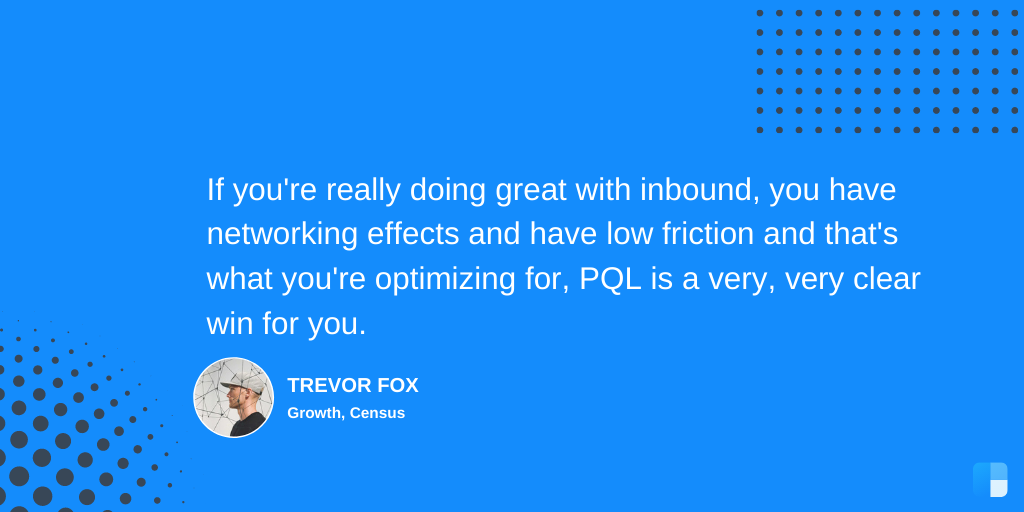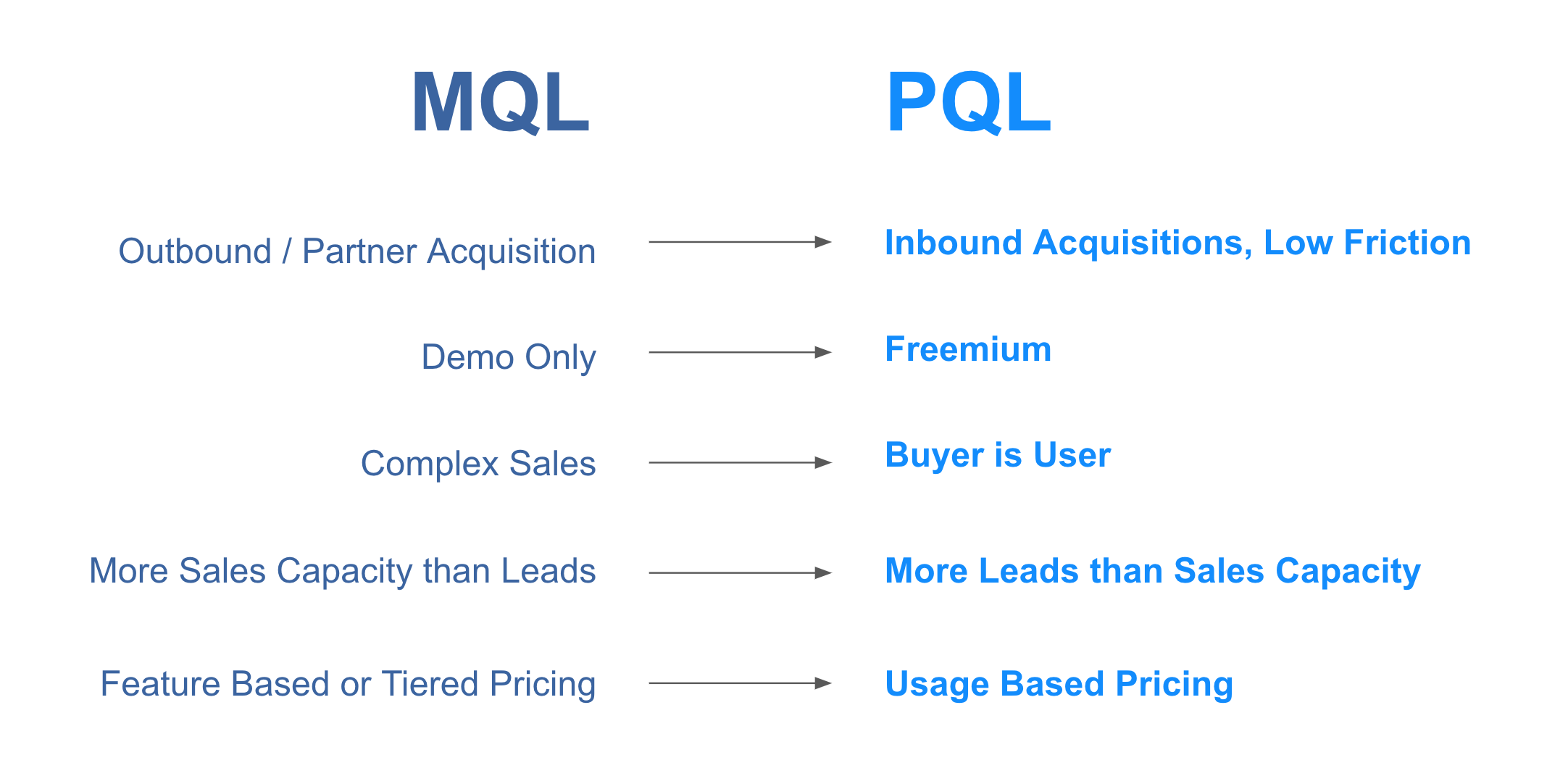When and how to develop a PQL framework
Should your company implement a PQL framework?
To help answer when — and how — your company should use PQLs, we tapped Trevor Fox of Census (and previously, Panoply) and Jessica Zhang of Notion (and previously, Slack) to share how their own companies have tackled this very question.
But first, what is a PQL?
A PQL, or product qualified lead, is a lead that has done a test-drive of a free version of your product and experienced some kind of meaningful value.
Compare this to an MQL, or marketing qualified lead, which is a lead that has expressed interest in your brand, likely by engaging with your marketing material.
Use a PQL framework to prioritize leads in sales (and beyond)
While the working definition of PQL varies from company to company, most product-led companies view it as a valuable KPI or heuristic to drive the sales team.
Companies that adopt a PQL framework use a scoring system to rate PQLs. They then use that rating system as a unified source of truth to prioritize the time and efforts of the sales team and other departments.
For example, at Notion, Jessica’s team uses PQLs to rate and prioritize sales leads. All known interaction for each lead is synthesized together into a score ranging from 1-100 scale.
“On a daily basis, we connect the data dots across different systems, both internal product usage as well as if they visited the website or if they participated in other programs,” Jessica says.
“We synthesize all of that information together to calculate a score. And on a nightly basis, we refresh that. So every morning when our sales team interacts with their dashboard, they have the most up-to-date information to help them prioritize their workflow.”
This PQL scoring process involves calculating not one, but two separate fit scores to help paint a full picture for the sales team:
- The domain score
- The persona score
This is important because, as Jessica points out, "product champions may not be the decision-makers" — a common scenario for product-led companies moving upmarket.
The domain score serves to answer the question: is this the type of account that has the potential to become a top 100 customer in the future? Next, they identify the common personas, or stakeholders, within each domain. Personas might include:
- Decision-makers
- Billing contacts
- Power users
- Community champions
“Based on the rich data that we have, we were able to infer different types of personas. So this way, when we leverage a product like Census to send out notifications or update Salesforce, we are able to provide this information for the SDRs and sales team on a particular domain,” she says.
Trevor says that at Census, the value of PQL scores goes beyond the sales team — serving as a shared company-wide metric that can be used by all departments to prioritize the most valuable channels.
“The most inspiring thing about it is that it's not only a score or a thing that you can use as guidance, but it's a KPI that every part of the business can measure against,” he says.
While working at Panoply, for example, the growth team, could see how many PQLs started their journey on specific landing pages and then double down on channels that were the most successful. The product team could optimize the score from the product experience. And sales would then get a bigger pool of qualified leads to work.
Regardless of your exact approach, the result of PQL scoring and profiling is a set of rich, contextual information that your teams can leverage.
When to use MQL versus PQL
So when should you implement a PQL framework versus the more traditional MQL approach?
Trevor’s thought process for using PQLs over MQLs involves looking at your customer journey and your sales process from top to bottom. His top five tips for when to embrace PQLs are as follows:
- You are already optimizing inbound acquisition with little to no friction
- You utilize a freemium model vs. relying on product demos
- Your typical user is also your buyer
- Your volume of leads is outpacing your sales capacity
- You have a usage-based pricing model
Whether you're product-led or not is the key. Trevor notes "PQL is a more modern way of approaching scoring, given that we have new ways of delivering software. So if you're really dependent on partner, outbound sales, demos — you're more fit for an MQL model, but if you're doing great with inbound, you have networking effects and low friction, PQL is a very clear win for you."
Both MQLs and PQLs have their challenges. The best solution is to use testing and your intuition to come up with the data that works best for your company.

Build a PQL model based on business pain points
If your company fits the product-led profile of the five characteristics Trevor outlined above, you might still be wondering if now is a good time to kick off a PQL-driven approach.
The answer is that when you start to have lots of stakeholder conversations around data pain points and data siloing, it might be time to consider moving to a PQL model.
“Sitting in the data org, we've definitely worked very cross-functionally with our business partners,” Jessica says — that's a position to start seeing pain points solidify in real time. Common pain points might include:
- Data is spread across too many different systems, requiring reps and other GTM roles to log into multiple systems to research whether leads are a fit
- There's no mature process for lead handoff that reflects the nuances of sales readiness
- There is a need to differentiate between product champions and decision-makers
“That is when we usually start...working with the leadership in different departments to start building a holistic idea on what the goal is. How are we going to measure success? And how are we going to do insight and work with business partners? That is when we know it’s time,” says Jessica.
The best PQL framework is more than a data model
Jessica defines a successful PQL framework as incorporating enablement, not just providing teams with PQL scores.
“When we gathered the feedback from our business partners, one of the pain points was definitely the silos. And that's when we realized, at both companies, at both Slack and Notion, that we want to build better alignment across different departments,” she says.
They worked closely with the marketing, sales, and finance teams to build out the models, iterate on them, and understanding how they were actually being used — aligning and educating everyone on "what a score of 80 means,” says Jessica. “How would it be incorporated into programs, and how would we measure the success of those programs?”

Your goal should be to make everyone’s job easier, not harder. That means creating clear workflows in addition to clear PQL score-building. As Jessica notes, "Building an accurate scoring model is one thing but actually making it part of the workflow is even more meaningful."
Want to learn more about PQLs and B2B SaaS lead qualification systems? Dive into our Modern Guide to Lead Qualification for 11 chapters of insights and tips on everything fron lead scoring and routing to tools and best practices for your company's growth stage.


